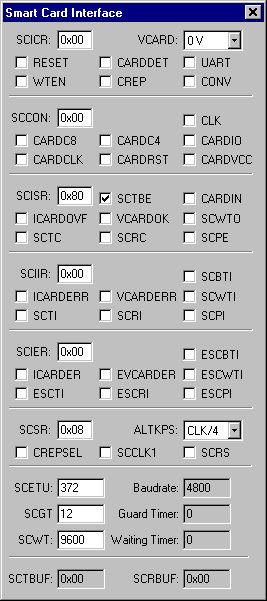|
||
| Products Download Events Support Videos | ||
Product Information
Device Database®
Downloads
Compliance Testing
Distributors
Peripheral Simulation
For Atmel AT8xC5122 — Smart Card Interface Block
Simulation support for this peripheral or feature is comprised of:
- Dialog boxes which display and allow you to change peripheral configuration.
- VTREGs (Virtual Target Registers) which support I/O with the peripheral.
These simulation capabilities are described below.
Multi-protocol Smart Card Interface Dialog

The Keil Debugger simulates the Multi-protocol Smart Card Interface. The configuration is reflected in the Smart Card Interface Dialog that you may open from the Peripherals Menu. Values of the SFRs that configure the Smart Card Interface are displayed in the dialog. You may use the controls in the dialog to override the settings configured by your target program.
SC_SIN VTREG
Data Type: unsigned int
The SC_SIN VTREG represents the serial input of the Multi-protocol Smart Card Interface. Values you assign to SC_SIN are input to this serial channel. You may assign input using the command window. For example,
SC_SIN='A'
causes the simulated microcontroller Smart Card Interface to receive the ASCII character A. If you want to use the SC_SIN VRTEG to simulate reception of multiple characters, you must be sure to delay for atleast one character time between successive assignments to SIN. This may be done using a signal function. For example:
signal void send_cat (void) {
swatch(0.01); /* Wait 1/100 seconds */
SIN='C'; /* Send a C */
swatch(0.01);
SIN='A';
swatch(0.01);
SIN='T';
}
The simulator assigns the value 0xFFFF to SC_SIN when the previous value is completely processed and a new value can be received. In addition to the SC_SIN VRTEG, the serial window allows you to input serial characters by simply typing. Serial characters that are transmitted by the Smart Card Interface appear in the serial window.
SC_SOUT VTREG
Data Type: unsigned int
The SC_SOUT VTREG represents the serial output from the simulated Multi-protocol Smart Card Interface. Whenever the Smart Card port transmits a character, the value transmitted is automatically assigned to SC_SOUT (which is read-only). You may read the value of SC_OUT to determine the character transmitted by your simulated program. For example,
S0OUT
outputs the value of the last character transmitted. You may use the SC_SOUT VTREG in a script to process transmitted data. For example,
signal void s0out_sig (void) {
while (1)
{
wwatch(S0OUT); /* wait for something in S0OUT */
printf ("Transmitted a %2.2X\n", (unsigned) S0OUT);
}
}
ProductsDevelopment Tools |
Hardware & Collateral |
Downloads |
Support |
Contact |
